Impacts of SST anomalies in the Indian-Pacific basin on Northwest Pacific tropical cyclone activities during three super El Niño years*
ZHAN Ruifen (占瑞芬) CHEN Baode (陈葆德) DING Yihui (丁一汇)
1 Shanghai Typhoon Institute of China Meteorological Administration, Shanghai 200030, China
2 National Climate Center and Laboratory for Climate Studies, China Meteorological Administration, Beijing 100081, China
1 INTRODUCTION
The El Niño-Southern Oscillation (ENSO) is the main mode dominating tropical interannual variability.Many studies have shown that the ENSO strongly influences the interannual variability of the genesis position and intensity of tropical cyclones (TCs) over the western North Pacific (WNP) (Lander, 1994;Chan, 2000; Wang and Chan, 2002; Camargo et al.,2007). During El Niño years, the TC genesis region over the WNP generally shifts eastward, the TCs have stronger intensities, and their tracks tend to recurve northeastward; the converse occurs during La Niña years. For example, there were as many as 16 intense TCs in 2015 but only 1 in 1999. Furthermore, Wang and Chan (2002) categorized ENSO events in terms of strength and they investigated the characteristics of TC activity under diff erent ENSO categories based on composite analysis. They identified ENSO strength as the dominant factor aff ecting TC activity and that a strong ENSO had an obvious role in modulating TC activity. However, despite the significant impact of the ENSO on TC activity over the WNP, there is little evidence of significant correlation between TC numbers and ENSO (Lander, 1994; Wang and Chan,2002; Zhan et al., 2011a), suggesting that TC activity over the WNP is also greatly modulated by other climatic factors.
In recent years, the impact of the sea surface temperature (SST) in the Indian Ocean on WNP TC activity has received considerable attention (Du et al.,2011; Zhan et al., 2011a, b; Tao and Cheng, 2012).These studies highlighted that the SST anomaly(SSTA) in the Indian Ocean, particularly its eastern region, is highly correlated with the number of TCs formed over the WNP. For example, fewer (more)TCs formed over the WNP corresponds to warm(cold) SSTs in the eastern Indian Ocean (EIO).Furthermore, based on observations and numerical simulations, Zhan et al. (2011a, b) proposed a physical mechanism regarding the impact of the EIO SSTA on TC genesis frequency over the WNP. They argued that warmer SSTs in the EIO would reduce the landsea thermal contrast, resulting in a weakened East Asian and WNP summer monsoon together with a weakened monsoon trough. Moreover, warmer SSTs would excite an eastward propagating Kelvin wave leading to reduced sea surface pressure over the WNP.Because of the compensating eff ects of lowered surface pressure, extratropical anomalous divergence and anticyclonic vorticity would be enhanced,inducing subsidence and leading to drier air in the mid-levels of the atmosphere. The combination of the weakened monsoon trough and the extratropical dynamical conditions would suppress the genesis of WNP TCs.
The three strongest El Niño events since the 1950s occurred in 1982/1983, 1997/1998, and 2015/2016.The SSTAs during these events in the Niño3.4 region all exceeded 2.0° C, which exerted profound eff ects on global weather and climate. It is reasonable to investigate whether TC activities during the three super El Niño years were analogous in terms of characteristics. If not, it is important to elucidate those aspects of TC activity determined by the super El Niño events. Most previous studies have concentrated on the impact on TC activity of a single factor, e.g.,the ENSO or the SSTG, without consideration of the relative contributions and synergistic eff ects of various factors in the context of the Indian-Pacific basin. This paper emphasizes the diff erences and similarities among TC activities during the developing years of three super El Niño events (1982, 1997, and 2015), and the related mechanisms from the viewpoint of the Indian-Pacific basin as a whole.
2 DATA, METHOD, MODEL DESCRIPTION, AND EXPERIMENT DESIGN
2.1 Data and methods
All TC statistics in this study were based on TC best-track data from the Shanghai Typhoon Institute of the China Meteorological Administration (CMA;Ying et al., 2014). As tropical depressions were detected with great uncertainty, only TCs with at least tropical storm intensity (maximum sustained 10-m wind speed: Vmax≥ 17.2 m/s) within 100° E–180° were considered here. There are various measures for TC activity. This study examined TC genesis number and the accumulated cyclone energy (ACE), which is an integrated measure of TC activity and is defined as the sum of the square of Vmaxat six-hourly intervals for all TCs each year (Bell et al., 2000). To understand ACE better, we also examined the TC days, defined as the accumulated duration of all TC records (Emanuel,2005), intense TC number with Vmax≥ 41.5 m/s, and TC number making landfall in China. Following Zhan et al. (2011a), we defined the period June–October(JJASO) as the typhoon season. In addition, this study also used the monthly extended reconstructed SST(ERSST v4) analyses from the National Oceanic and Atmospheric Administration (NOAA; Smith and Reynolds, 2004), and daily and monthly atmospheric data from the National Centers for Environmental Prediction-National Center for Atmospheric Research(NCEP-NCAR) reanalysis data (Kalnay et al., 1996).
Previous studies have shown that low-level barotropic energy conversion ( K m Ke) has marked eff ect on TC genesis and development (Shapiro, 1978;Maloney and Hartman, 2001). In this study, we compared the similarities and diff erences ofKmKein the developing years of the super El Niño events. In Cartesian coordinates, the termKmKecan be written as

whereuandvrefer to the zonal and meridional winds,respectively, an overbar is indicative of a basic state defined as an 11-day running mean, and a prime indicates an eddy or synoptic component defined as the residual. The four terms on the right-hand side of Eq.1 indicate barotropic energy conversions due to the convergence and meridional shear of the zonal wind and the zonal shear and convergence of the meridional wind. These terms are jointly determined both by the structure of the disturbances and by the large-scale flow pattern. This study used the daily NCEP-NCAR reanalysis data to decompose the basic state and the eddy component, and then calculated the average in the typhoon season for each item.
Similar to the method used in Rauthe and Paeth(2004), the contributions of the individual factors to TC activity were assessed using the predictorpredictand relationships in the multiple-linearregression model. In this study, the summer ENSO index, EIO SSTA, and spring SSTG were considered as the predictors, and ACE and TC number in the typhoon season were the two predictands. According to these predictors and predictands, two multiplelinear-regression models were developed. The contribution was calculated by multiplying the standardized time series of the predictor with the corresponding regression coeffi cient.
2.2 Model description and experiment design
The European Centre Hamburg Model (ECHAM)version 4.8, developed at the Max Planck Institute for Meteorology, was employed as the atmospheric general circulation model (GCM, Roeckner et al.,1996) in this study. The model used a 19-level hybrid sigma-pressure coordinate system with T42 horizontal resolution. Physical parameterization options used in this study included turbulent surface fluxes calculated using Monin-Obukhov similarity theory, horizontal diff usion in a hyper-Laplacian form, the ECMWF radiation scheme, and parameterization of cumulus convection (shallow, mid-level, and deep) based on the bulk mass flux scheme developed by Tiedtke(1989) and later modified by Nordeng (1994).
To elucidate the contributions of individual SST factors and their joint impact, the factor separation method in numerical simulations, proposed by Stein and Alpert (1993), was applied in this study. It can quantify directly the contributions of each model component to system skill, and it can conveniently quantify the beneficial or detrimental interactions between the diff erent components. As TC activity in 1997 was similar to the developing years of strong El Niño events, as shown in the following, this year is not discussed further with regard to the simulations.Based on Figs.4 and 5, the roles of three SST factors in TC activity were examined, including SSTAs in the EIO (10.0° S- 22.5° N, 75° - 100° E) and in the Niño 3.4 region (5° S- 5° N, 120° - 170° W), and spring SSTG,which is defined as the SST diff erence between the SWP (20°–40°S, 160°E–170°W) and the WWP (0°–16°N, 125°–165°E). It should be noted that the spring SSTG anomaly aff ects TC activity via air–sea interactions (Zhan et al., 2013), which cannot be reproduced directly by the ECHAM GCM. Thus, in the following, the SWP SSTA in summer replaced the spring SSTG anomaly in all the sensitivity experiments. The former is an important component of the latter; therefore, the significant contribution of the SWP SSTA can be considered representative of the spring SSTG.
乡村旅游产业与精准扶贫融合催生了新业态,这一融合为农村贫困地区注入新的竞争力和创造力,为乡村振兴发展提供动能,为乡村产业兴旺提供助力,为乡村人民脱贫提供支撑。乡村旅游产业与精准扶贫融合发展还有助于促进农村地区产生协同效应,这将促使更多的发展要素和资源流向农村地区,进一步促进农村地区的生产活动和生态环境有机契合,在更多领域、更大范围、更高水平上形成城乡融合发展新格局。
Two groups of experiments were designed for 1982 and 2015 using the ECHAM GCM, as outlined in Table 1. Each group consisted of four 30-year experiments integrating from January to December of each year, which comprised a control run (CTRL)with observed SSTs in 1982 or 2015 and three sensitivity runs. The final 20 ensemble mean results from June–October were analyzed in this study. The first group was used to examine the contributions of EIO SSTA, ENSO, and spring SSTG in 1982. Asmentioned above, the spring SSTG anomaly was replaced by the SWP SSTA in summer in the simulations. In the first group, the three sensitivity experimentsf0_1,fEN_1, andfEIO,SWP_1were identical to the CTRL in 1982, except that the observed 30-year climatological monthly mean SSTs were set in the EIO (10.0° S- 22.5° N, 75° - 100° E), Niño 3.4(5° S- 5° N, 120° - 170° W), and SWP (20°–40°S,160°E–170°W), in the EIO and SWP, and in the Niño 3.4 domains, respectively. Similarly, the three sensitivity experimentsf0_2,fEN_2, andfEIO_2in the second group, designed to examine the contributions of ENSO and EIO SSTA in 2015, were identical to the CTRL, except that the observed 30-year climatological monthly mean SSTs were set in the EIO and Niño 3.4,in the EIO, and in the Niño 3.4 domains, respectively.
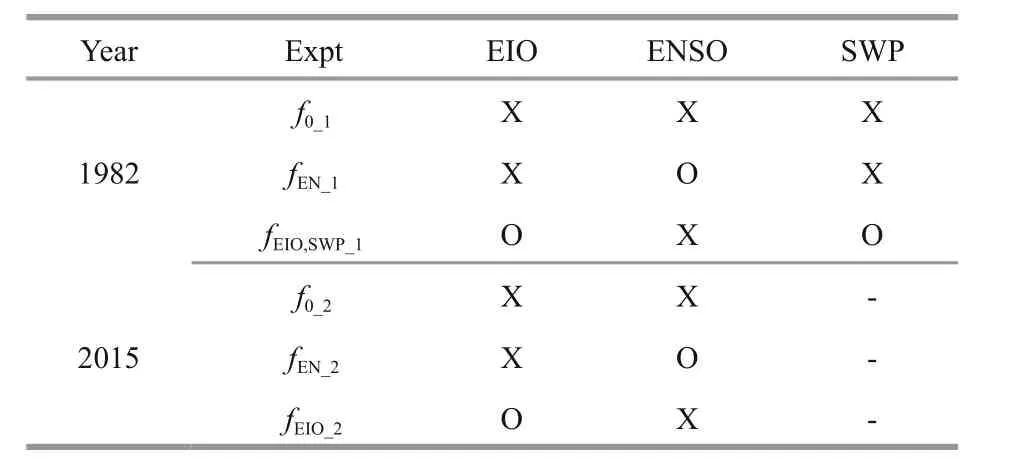
Table 1 Experiments designed for factor separation analysis
As shown in Table 2, the diff erence between the CTRL andf0suggests the joint impact of the main factors, and the diff erences between the individual factor experiments andf0indicate the individual contributions of those factors.

Table 2 Contributions of the main factors and their interactions, calculation method, and the mechanisms leading to the contributions
3 OVERVIEW OF TC ACTIVITY IN THE DEVELOPING YEARS OF THE THREE SUPER EL NIÑO EVENTS
Table 3 lists the numbers of all TCs and intense TCs, the ratio of intense TCs to all TCs, number of days of TC activity, ACE, and number of TCs making landfall in China in the three super El Niño years. The averaged TC metrics for strong El Niño years and for 1981–2010 are shown for comparison. In this study,strong El Niño years were defined according to the normalized time series of the ENSO index with SSTA ≥ 1 standard deviation during the typhoon season during 1980–2015 (1987, 1991, 2002, and 2004). Note, to avoid the impact of super El Niño events, the three super El Niño years were excluded from the strong El Niño years. Similar to previous studies, TC activity was found intensified in all three super El Niño years; the numbers of intense TCs and of TC days were greater than the climatological means, and the ratio of intense TCs to all TCs was higher as well. Particularly, in 2015, all these characteristics were further above the climatological means. In addition, there were fewer TCs making landfall in China, which might be related to more TC tracks with northeastward recurvature. More interestingly, during the super El Niño years, there were greater numbers of TC days, greater TC intensities, and fewer TCs making landfall in China than in strong El Niño years. It suggests that super El Niño events play a greater role than strong El Niño events in modulating TC activity. Nevertheless, there was clear diff erence in TC genesis in the three super El Niño years; the number of TCs was around 20 in both 1982 and 1997, which appears normal and is similar to strong El Niño years, but there were only 16 TCs generated in 2015, i.e., considerably fewer than the climatological mean. It indicates that ENSO has no significant impact on the total number of TCs generated, even though it reached the super category.
Figure 1 shows the anomalies of TC genesis and occurrence numbers (frequencies) relative to the climatological mean of 1981–2010 for the three super El Niño years, wherein the frequencies were determined within a 10°×10° box by counting the numbers of TC genesis and their occurrence. In addition, the positions of TC genesis (green circles)and tracks (green lines) are shown. It is clear that during all three super El Niño years, TCs generated mainly in the south of the WNP and they tended to recurve from northwestward to northeastward,resulting in fewer landfalls in China, which is largelyin agreement with previous studies (Wang and Chan,2002; Camargo et al., 2007). However, there is clear diff erence in the zonal distribution of the locations of TC genesis. In both 1997 and 2015, the location of TC genesis shifted eastward with a positive anomaly center between 165° E and 170° E, and a negative anomaly center near 130° E. The mean locations of TC genesis in these two years were 143° E and 145° E,respectively. Compared with the climatology (around 135° E), the displacement was 8°–10° longitude eastward, much larger than one standard deviation(4.6°). This finding is in good agreement with other studies of the modulating eff ects of strong El Niño events (Wang and Chan, 2002; Camargo et al., 2007).In comparison, in 1982, the location of TC genesis was displaced southward, not eastward. Most TCs appeared to the west of 150° E, and the positive anomaly extended around 120° E with the mean location of genesis at 137° E, which is close to the climatology. With respect to the tracks, in addition to the northeastward recurving tracks, there were also substantial westward tracks in 1982. The location of genesis of these TCs was largely to the west of 130° E,inconsistent with 1997, 2015, and the averaged strong El Niño years (figure not shown). It is likely that the increase in westward tracks in 1982 was associated with the location of TC genesis.
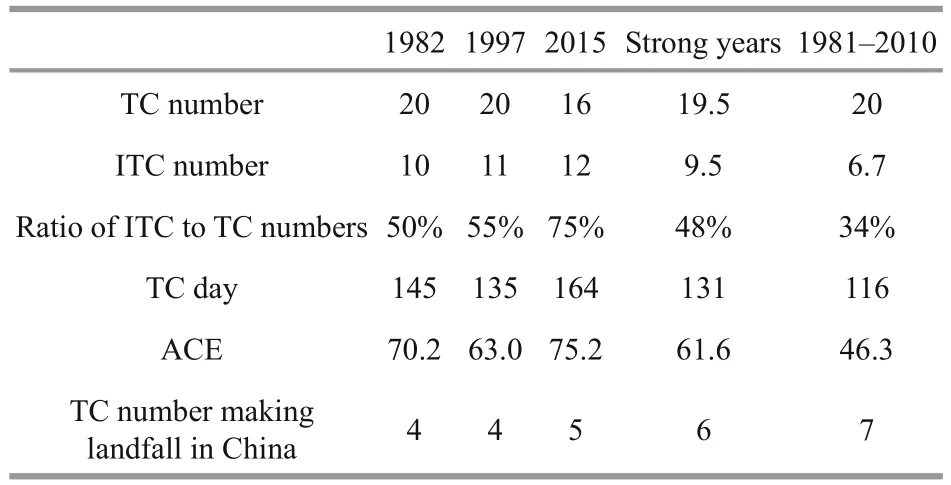
Table 3 Numbers of all TCs generated and intense TCs(ITCs), ratio of ITC to all TC numbers, days of TC activity, ACE, and number of TCs making landfall in China in 1982, 1997, and 2015, and their corresponding averages in strong El Niño years and in 1981–2010
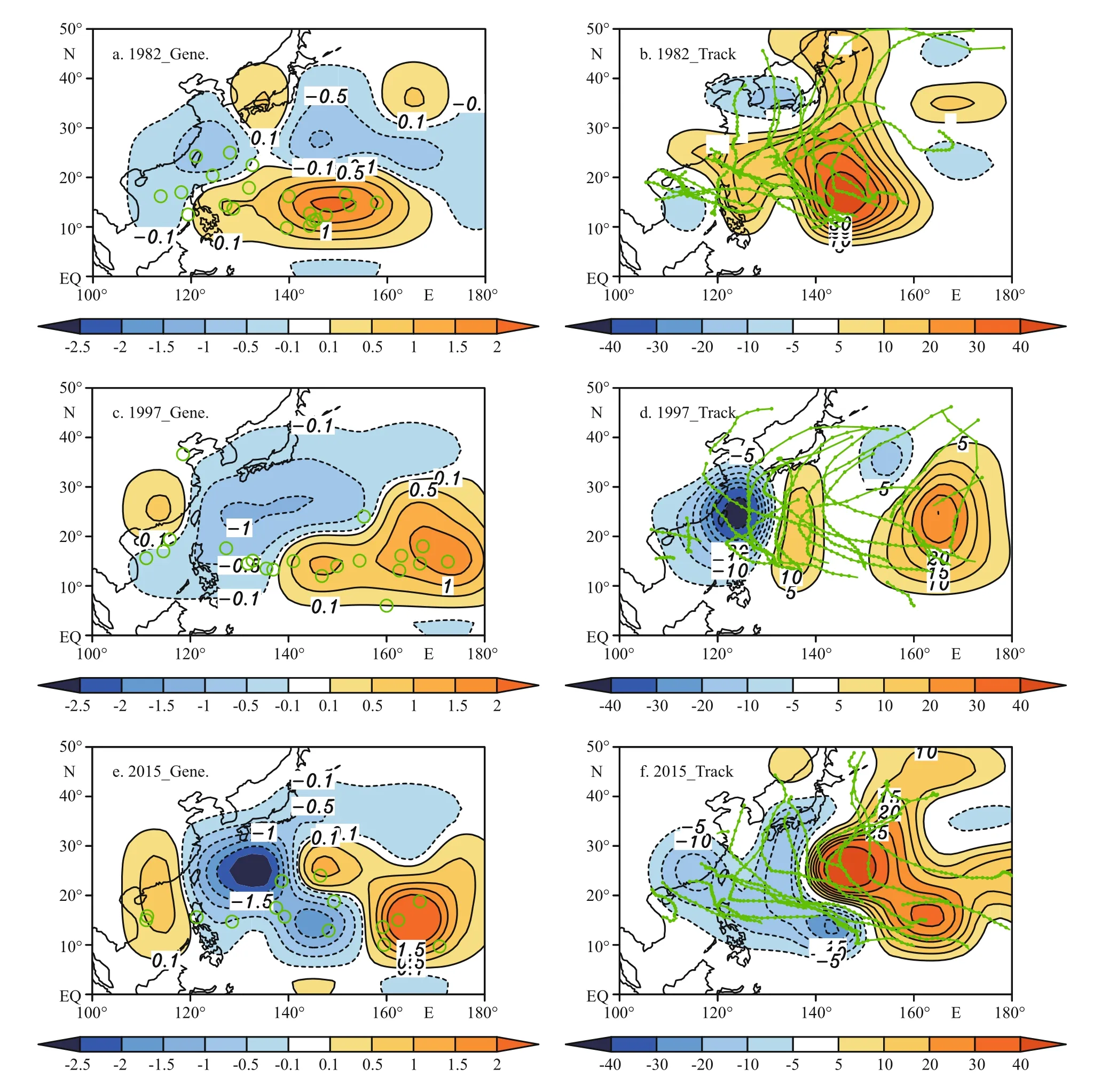
Fig.1 Diff erences in frequencies of TC genesis (left panels) and TC occurrence (right panels) between super El Niño developing years and 30-year climatological mean
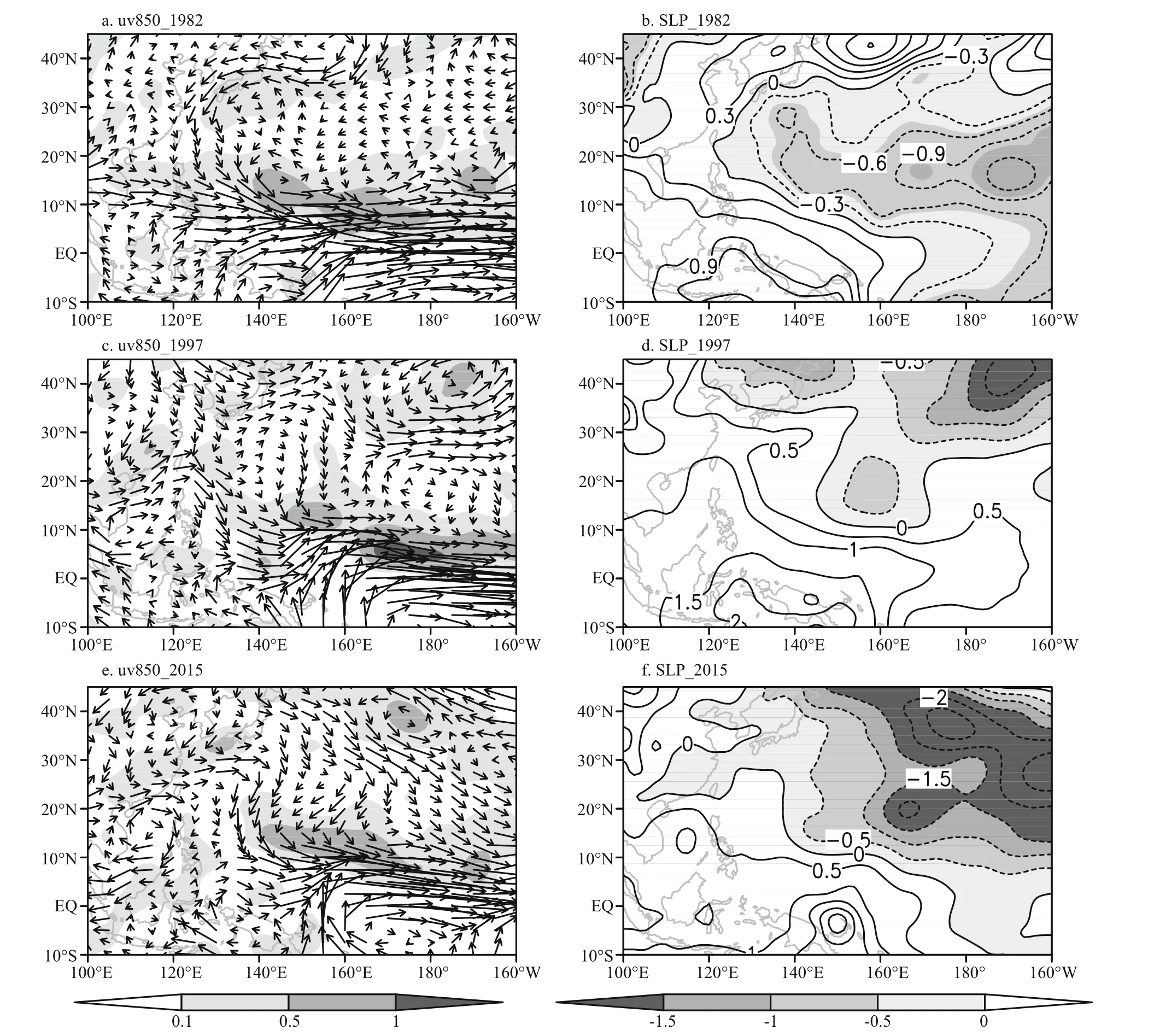
Fig.2 Anomalies in (a), (c), and (e) 850-hPa horizontal wind (vector, 5 m/s) and vorticity (shaded, 1.0× 10-5/s), and (b), (d), and(f) sea level pressure (SLP, hPa) during the typhoon season in (a) and (b) 1982, (c) and (d) 1997, and (e) and (f) 2015
4 RESPONSES OF ATMOSPHERIC CIRCULATIONS
TC activity is closely related to local dynamic and thermodynamic conditions (Chen and Ding, 1979).To explore the origin of anomalous activity of TCs in the three super El Niño years, we start by examining the responses of large-scale circulation fields to super El Niño events that tightly modulate TC activity.Figure 2a–f shows the 850-hPa wind, vorticity, and sea level pressure (SLP) anomalies for the three super El Niño years. It is evident that the super El Niño events drove anomalous equatorial westerlies to the east of 140° E. This largely increased the cyclonic shear of zonal winds over the eastern WNP TC genesis region. Consequently, the SLP over the eastern WNP TC genesis region was dominated by negative SLP anomalies. This enhanced TC genesis over the eastern WNP and it was favorable for more intense TCs,consistent with previous studies based on strong El Niño years (Wang and Chan, 2002; Zhan et al.,2011a). However, comparison of Fig.2a, c, and e shows that the low-level wind fields over the western WNP were considerably diff erent. In 1982, a lowlevel westerly anomaly extended all the way from the South China Sea to the equatorial central Pacific, and in the primary area where TC genesis occurred, a strong anomalous cyclonic circulation was prevailing;correspondingly, a low-level positive vorticity anomaly developed. Obviously, this circulation structure was favorable for a westward displacement of TC genesis. In 1997, the anomalous equatorial westerlies and positive vorticity appeared to the east of 130° E, and the anomalous anticyclonic circulation covered the region from west of 130° E to the South China Sea with a more eastward WNP monsoon trough, leading to the southeastward displacement of TC genesis. In 2015, the position of the anomalous equatorial westerlies and positive vorticity was further eastward than in 1997, which was mainly to the east of 140° E. Thus, the anomalous anticyclonic circulation and negative vorticity dominated the area to the west of 140° E, favorable for fewer TC numbers and eastward displacement of TC genesis. In 1982,the negative SLP anomaly was further westward and larger than in the other two years, as shown in Fig.2b,d, and f, favorable for the westward shift of the TC genesis location.
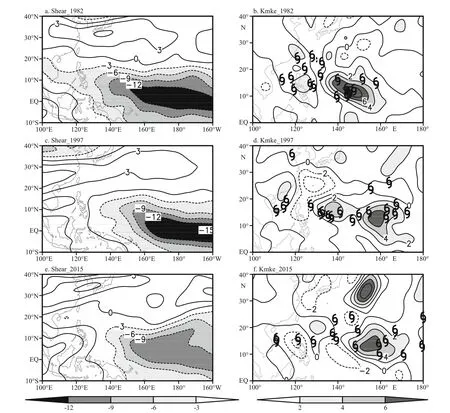
Fig.3 As Fig.2 but for vertical zonal wind shear between 200 and 850 hPa (left panels, m/s) and barotropic energy conversion( KmKe; right panels, 10 -5 m 2/s 3)
Figure 3 shows the anomalies of vertical shear of the zonal wind between 200 and 850 hPa and the barotropic energy conversion (KmKe) during the typhoon seasons of the three super El Niño years.Previous studies have indicated that weak vertical wind shear favors strong TC activity (Wang and Chan,2002; Zhan and Wang, 2016). It can be found that during the three super El Niño years a strong negative vertical wind shear anomaly covered most of the tropical western Pacific, corresponding to a large positiveKmKeanomaly, indicating the conversion of eddy kinetic energy from a strong mean flow. This is consistent with the structure of the dynamical fields during the development of an El Niño event, as shown in Fig.2, which helps intensify TC activity. However,in 1982, the negative anomaly of vertical wind shear in the tropical western Pacific clearly shifted westward. Consequently, two centers of positiveKmKeanomaly appeared from west to east: one at around 145° E and the other at around 125° E,corresponding to the major areas of TC genesis.Comparatively, the negative anomaly of vertical wind shear was located further eastward in both 1997 and 2015, and positiveKmKeanomalies occurred in the southeastern WNP. Notably, in 2015,KmKeto the west of 145° E was weaker than in 1997, which resulted in the formation of fewer TCs.
The above analysis shows the configurations of the large-scale circulations in the central and eastern parts of the WNP were similar during the super El Niño years, implying that the super El Niño events played a dominating role in modulating the tracks and intensity of TCs. However, diff erences exist in the patterns of the large-scale circulations in the western WNP where the modulating eff ects of El Niño are relatively weak.Thus, it is possible that the weak eff ects of El Niño resulted in the large diff erences in both frequency of TC occurrence and position of TC genesis among the three super El Niño years. However, it is important to consider the relative contributions of factors other than El Niño to the modulation of TC activity.
5 CONTRIBUTIONS OF SSTAS IN THE INDIAN-PACIFIC BASIN
5.1 SSTA distributions in developing years of super El Niño events
SST, as the most important surface forcing, has profound impact on TC activity. As mentioned in the introduction, in the Indian-Pacific basin, in addition to ENSO, the EIO SSTA, WWP, and SSTG all significantly influence TC activity over the WNP. The global SST anomaly during the typhoon season of the three super El Niño years, illustrated in Fig.4, shows an enormous strong positive SST anomaly extending over the equatorial central and eastern Pacific Ocean.This SSTA was strongest in 1997, followed in descending order by 2015 and 1982. Moreover, it is intriguing that the distributions of EIO SSTA and the SWP SSTA, which is one element that determines the SSTG during the typhoon season, were diff erent in all three years. In 2015, there was a very large area with positive SSTA in the EIO, but it was negative in 1982.The SWP SSTA was negative in 1982, and between negative and positive anomalies in 2015. In 1997,both the EIO and SWP SSTAs were small, ranging mainly from -0.25° C to 0.25° C.
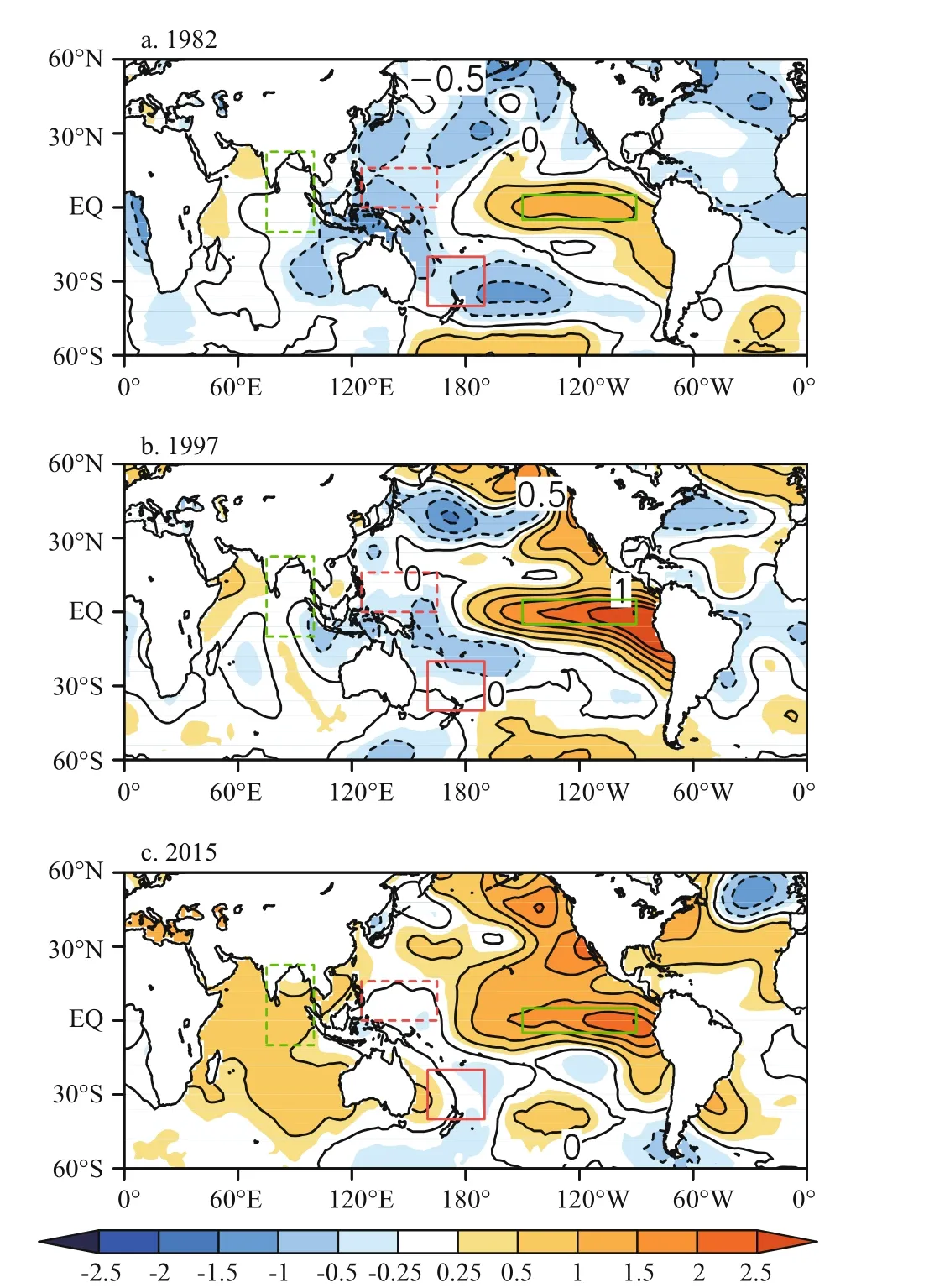
Fig.4 Sea surface temperature anomalies (° C) during the typhoon season in (a) 1982, (b) 1997, and (c) 2015
To examine quantitatively the variation of the SST index in the key areas, the time series of the EIO SSTA and spring SSTG indices are shown in Fig.5.Here, the EIO SSTA index is defined as the SSTA averaged in the region (10.0° S- 22.5° N, 75° - 100° E),and the SSTG is defined as the diff erence in SSTAs between the SWP (20°–40°S, 160°E–170°W) and the WWP (0°–16°N, 125°–165°E) in boreal spring(MAM) based on the ERSST v4 data. It can be seen that both the EIO SSTA and the SSTG were anomalously negative in 1982. Although they had small amplitudes individually, they might collectively have aff ected TC activity to a certain degree. In 1997,both the EIO SSTA and the SSTG anomalies were around zero, indicating their weak impact on TC activity. In 2015, the SSTG anomaly was close to zero, suggesting its eff ect might have been negligible,but the EIO SSTA was its warmest since 1980.Previous studies (Zhan et al., 2011a, b; Tao and Cheng, 2012) have shown that an anomalous anticyclonic circulation exists in the region of TC genesis over the WNP in association with a warmer EIO SSTA, and that the subtropical high enhances and extends further westward, suppressing TC genesis. The circulation pattern in 2015, shown in Fig.2e, is similar to that described in the above studies,implying that reduced TC activity is related to an extremely warm EIO SSTA.
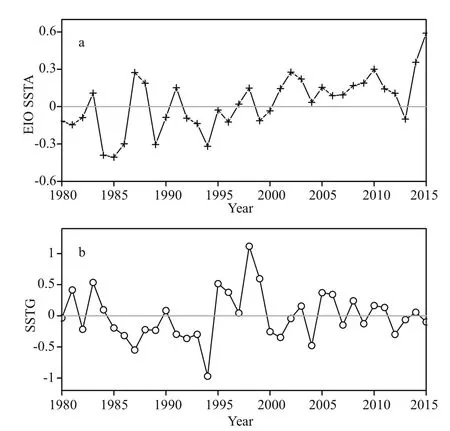
Fig.5 Time series of (a) EIO SSTA in the typhoon season and (b) spring SSTG anomaly
5.2 Contributions of SST factors in the Indian-Pacific basin
Multivariate regression is used to analyze the contributions from diff erent SST factors. Figure 6 shows the annual contributions to ACE and to the number of TCs generated from ENSO, EIO SSTA, and SSTG as well as from their combination. In general,the correlation coeffi cient between the fitted ACE of the three SSTA factors and the observed ACE is as high as 0.90, and the deviation is only 0.5×105m2/s2,which is far less than one standard deviation(4.6×105m2/s2). For the fitted number of generated TCs, the correlation with the observations is 0.84 with a deviation of 1.8, which is also much less than one standard deviation (4.8). From the above, it is evident that these three SST factors explain the interannual variability of WNP TC activity to a large degree.
During the three super El Niño years, the ENSO contribution almost coincided with the observed ACE, and very little contribution was evident from the EIO SSTA and SSTG, indicating the dominant modulating eff ect of the El Niño events on TC intensity. However, the ENSO contribution to the TC number (Fig.6b) was very small, irrespective of whether it was a strong El Niño year, which is consistent with previous studies (Lander, 1994; Zhan et al., 2011a). In 1982, the EIO SSTA and SSTG were the factors that dominated TC genesis, but in 2015,the contribution of EIO SSTA was very close to the observation with near zero contribution from the other two factors, suggesting that EIO SSTA is indeed the primary factor that modulates TC genesis.
To substantiate the analysis above, we performed six sensitivity experiments using the ECHAM 4.8 GCM. As mentioned in Section 2.2, the method of separating factors can diff erentiate the eff ects of the various factors; thus, it was used to examine further the individual contributions from the diff erent SST factors in the Indian-Pacific basin. Here, the contribution from each factor is defined as the diff erence between the experiment in which the factor is equal to the observation and that in which all factors are equal to the climatology (f0), as outlined in Section 2.2. Note, in all the sensitivity experiments, the SWP SSTA in summer replaces the spring SSTG anomaly,as mentioned in Section 2.2. As the large-scale conditions related to TC activity match each other,only the simulations of 850-hPa circulation are shown here for simplicity.
Figure 7 shows the relative contributions to lowlevel circulation in the WNP from the ENSO, EIO,and SWP SSTAs in 1982 individually, as well as their combined eff ect. Comparison of Figs.7a and 2a shows that the combined eff ect of the three factors resembles the anomalies in the corresponding years. The uniform low-level westerly anomaly from the South China Sea to the equatorial central Pacific Ocean and the anticyclonic circulation over the main area of TC genesis are reproduced well, indicating these three factors can surely aff ect TC activity by modulating the large-scale circulation. It should be highlighted that the simulated anomalous anticyclone near 30° N(Fig.7a) is further westward and stronger than observed (Fig.2a); however, it does not alter the overall conclusions of the present study. In the ENSO experiment (EXPEN_1), there is a strong low-level westerly anomaly east of 145° E, this favors strong TC activity and the displacement of TC genesis further eastward. For the combined experiment of EIO and SWP SSTAs (EXPEIO,EAU_1), the prominent features are a strong low-level westerly anomaly west of 150° E and a low-level cyclonic circulation over the main region of TC genesis, which favor TC genesis in the western WNP. In addition, the experiments considering the factors of EIO and SWP SSTAs individually indicate that the eff ects are relatively weak (not shown). In summary, the strong TC activity in 1982 was related to the super El Niño, but the change in the location of TC genesis resulted from the collective eff ects of ENSO, EIO, and SWP SSTAs,consistent with conclusions based on the multivariate regression analysis.
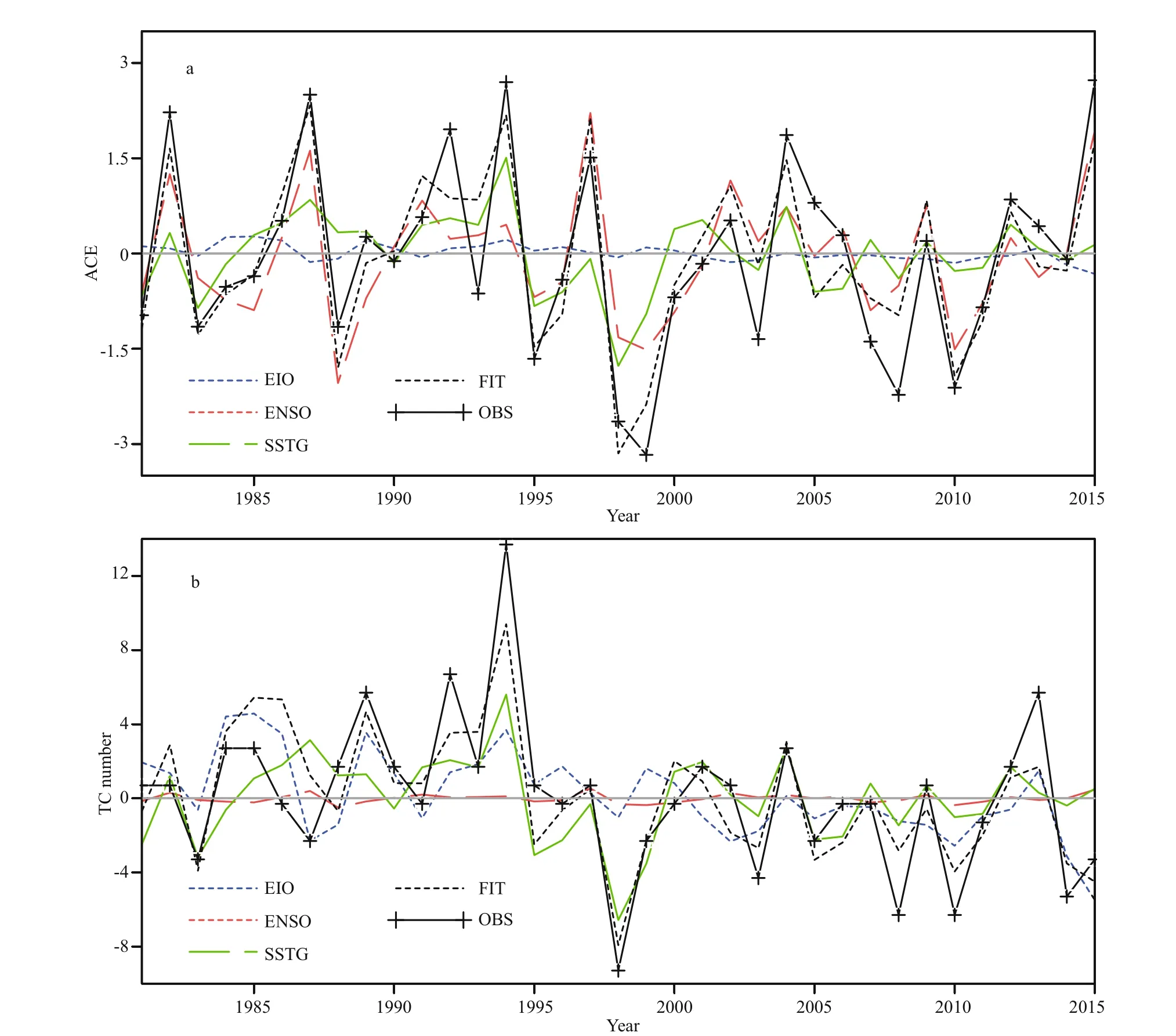
Fig.6 Interannual variations of contributions of the three individual factors and their combination to the seasonal (a) ACE variability and (b) TC number in the typhoon season
Figure 8 shows the respective and collective contributions from ENSO and EIO SSTA to the lowlevel circulation over the WNP in 2015. Compared with the observed anomaly, the combined eff ect of the two factors reproduced well the strong westerly anomaly east of 130° E and the anomalous anticyclone in the TC genesis region, implying their very important role in regulating TC activity. From the ENSO and the EIO SSTA experiments, it can be inferred that the strong westerly anomaly to the east of 140° E is due to the super El Niño, and that the weakening or interrupting of the westerly anomaly to the west of 140° E is the result of the impact of the EIO SSTA.Moreover, Fig.8c shows the anomalously warm EIO excited a strong anomalous anticyclone over the region of TC genesis, which is the primary reason that the anomalous anticyclonic circulation dominated the anomaly field west of 140° E and thus suppressed TC genesis. To summarize, the intensified TC activity in 2015 was the result of modulation by the super El Niño and the reduced TC number was due to an anomalously warmer EIO.

Fig.7 Relative contributions of the main factors to 850-hPa horizontal wind anomalies and their combined effect based on the control experiment and various sensitivity experiments in the typhoon season in 1982
6 CONCLUSION AND DISCUSSION
In this paper, we investigated the eff ects of SSTAs in the Indian-Pacific basin on TC activity over the WNP in the developing years of three super El Niño events.The SST factors in the key areas were selected based on previous studies, and they included the SSTAs in the Niño 3.4 and EIO regions, and the spring SSTG.
In the super El Niño years, TC activity was obviously enhanced, TC days increased, TC tracks tended mostly to recurve along the coasts, and fewer TCs made landfall in China. All the above characteristics are consistent with the strong ENSOTC relationship but further above the climatological means than in strong El Niño years. Results indicate that the super El Niño events evidently modulated the intensity and tracks of the TCs. Consistent with previous studies, the impact of the super El Niño events on TC activity is explained dynamically in relation to the changes in the large-scale environmental flow and the associated barotropic eddy-mean flow interaction. Anomalous convective heating in the central-eastern Pacific, induced by the super El Niño,triggers anomalous large-scale equatorial westerlies in the tropical WNP. This large-scale atmospheric setting results in reduced SLP and strong vertical shear of the large-scale zonal wind in the main region of TC genesis over the WNP. Both these factors contribute to the barotropic energy conversion from the large-scale flow to synoptic disturbances, favoring TC genesis over the eastern WNP and TCs that are more intense. However, there were apparent diff erences in the numbers of TCs and the locations of their genesis among the diff erent super El Niño years.The TC number was normal in 1982 and 1997, but it was much lower than normal in 2015. The location of TC genesis was further eastward in both 1997 and 2015, but it was further westward in 1982; its mean location was close to normal, which is inconsistent with the general results of strong El Niño events.
Based on the multivariate regression analysis and the GCM sensitivity experiments, it was found that in the super El Niño years, despite the vital eff ect of SSTA over the equatorial central-eastern Pacific,anomalous TC activity was the result of the collective eff ects of SSTAs in diff erent key areas over the Indian-Pacific basin (i.e., the ENSO, EIO, and spring SSTG). In 1982, the EIO SSTA and spring SSTG showed negative anomalies, followed by an enhanced anomalous cyclone in the western WNP and increased equatorial vertical wind shear. This led to intensified conversion of eddy kinetic energy from the largescale flow, which favored the westward shift of TC genesis. In 2015, the EIO SSTA was extremely warm and the anomalous anti-cyclone in the western WNP was enhanced, resulting in fewer TCs.
In this study, we examined only the impacts of three SST factors in the Indian-Pacific basin on TC activity during super El Niño years. Actually, as mentioned in the introduction, there could be other factors that modulate TC activity, which deserve further study. In addition, the impact of spring SSTG on TC activity involves air-sea interaction; however,the model used in this study is an atmospheric GCM in which the spring SSTG was taken directly from the SWP SSTA, a vital component of the spring SSTG.Thus, the related conclusions need to be further verified using an air-sea coupled global model.
It is noted that the eff ect of seasonal variability on TC activities is important. However, despite being another interesting topic, we did not consider it here;instead, the focus was on the entire contribution of the SST anomalies in the Indian-Pacific basin to TC activities during the typhoon season. Furthermore, it is noted that the eff ect of climate change on SST distribution is evident, as shown in Figs.4 and 5.Many previous studies have shown that climate change has an important role in atmospheric circulation and thereby, on TC activities (Webster et al., 2005; Kossin et al., 2014). For example, Kossin et al. (2014) revealed a significantly poleward migration of the mean latitudinal location of the TC lifetime maximum intensity (LMI) over the past 30 years.However, the annual mean latitude of LMI in 2015 dropped to its lowest values since 1990 (figure not shown). In this sense, the eff ect of the ENSO variability on the mean latitudinal location of the TC LMI off set that of climate change remarkably. In future work, we plan to examine the ENSO-TC relationship for evidence of alteration under the background of climate change.
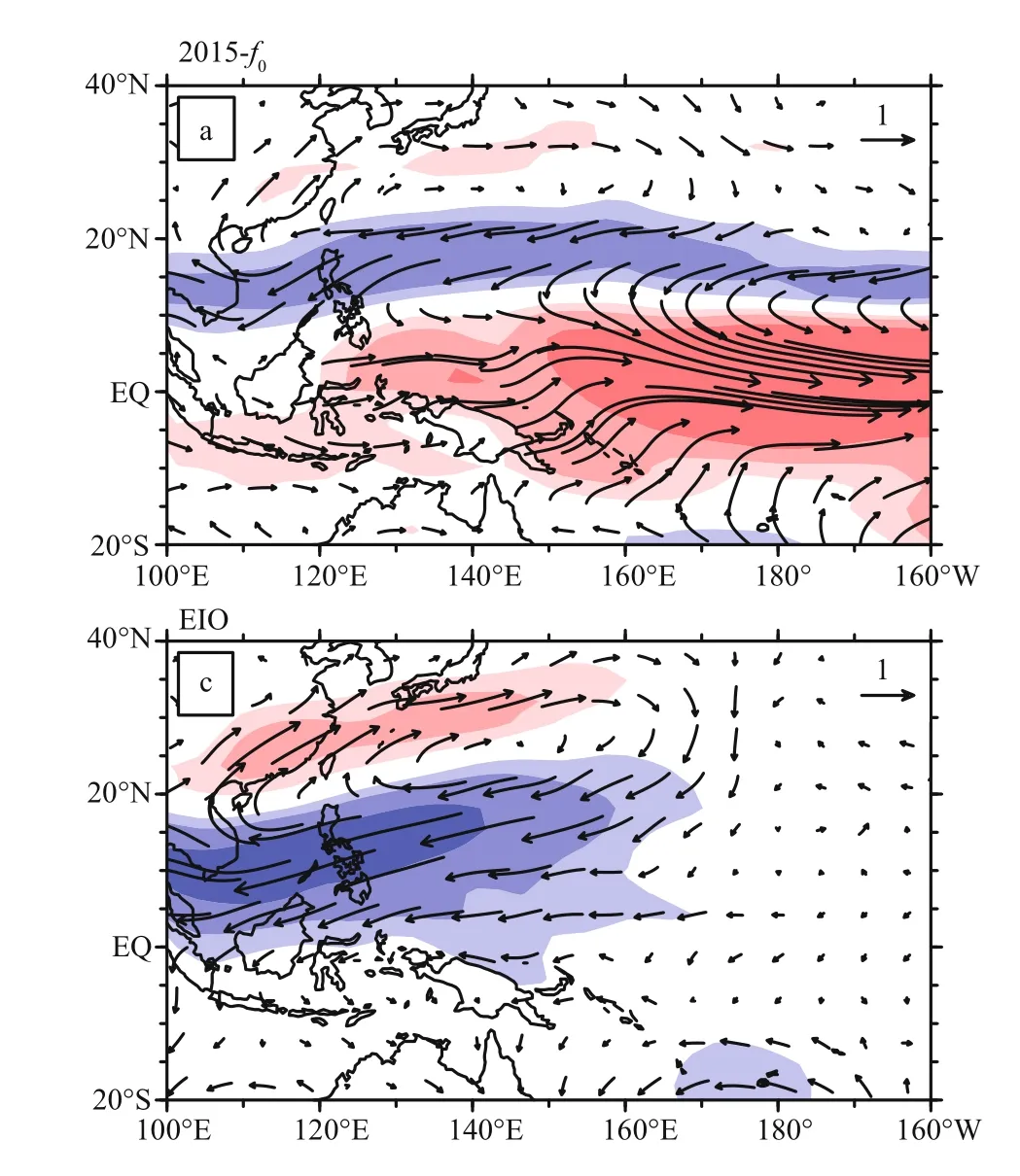
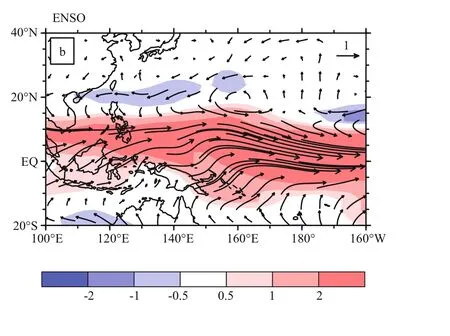
Fig.8 As Fig.7 but for 2015
Bell G D, Halpert M S, Schnell R C, Higgins R W, Lawrimore J, Kousky V E, Tinker R, Thiaw W, Chelliah M, Artusa A.2000. Climate assessment for 1999. Bull. Amer. Meteor.Soc., 81(6): S1-S50, https://doi.org/10.1175/1520-0477(2000)81[s1:CAF]2.0.CO;2.
Camargo S J, Emanuel K A, Sobel A H. 2007. Use of a genesis potential index to diagnose ENSO eff ects on tropicalcyclone genesis. J. Climate, 20(19): 4 819-4 834, https://doi.org/10.1175/JCLI4282.1.
Chan J C L. 2000. Tropical cyclone activity over the western North Pacific associated with El Niño and La Nina events.J. Climate, 13(16): 2 960-2 972, https://doi.org/10.1175/1520-0442(2000)013<2960:TCAOTW>2.0.CO;2.
Chen G H, Huang R H. 2008. Influence of monsoon over the warm pool on interannual variation of tropical cyclone activity over the western North Pacific. Adv. Atmos. Sci.,25(2): 319-328.
Chen L S, Ding Y H. 1979. An Introduction to Typhoons over Northwest Pacific. Science Press, Beijing, China. p.1-10.(in Chinese)
Du Y, Yang L, Xie S P. 2011. Tropical Indian Ocean influence on Northwest Pacific tropical cyclones in summer following strong El Niño. J. Climate, 24(1): 315-322,https://doi.org/10.1175/2010JCLI3890.1.
Emanuel K. 2005. Increasing destructiveness of tropical cyclones over the past 30 years. Nature, 436(7051): 686-688, https://doi.org/10.1038/nature03906.
Huo L W, Guo P W, Hameed S N, Jin D C. 2015. The role of tropical Atlantic SST anomalies in modulating western North Pacific tropical cyclone genesis. Geophys. Res.Lett., 42(7): 2 378-2 384, https://doi.org/10.1002/2015GL063184.
Kalnay E, Kanamitsu M, Kistler R et al. 1996. The NCEP/NCAR 40-year reanalysis project. Bull. Amer. Meteor.Soc., 77(3): 437-471, https://doi.org/10.1175/1520-0477(1996)077<0437:TNYRP>2.0.CO;2.
Kossin J P, Emanuel K A, Vecchi G A. 2014. The poleward migration of the location of tropical cyclone maximum intensity. Nature, 509(7500): 349-352, https://doi.org/10.1038/nature13278.
Lander M A. 1994. An exploratory analysis of the relationship between tropical storm formation in the Western North Pacific and ENSO. Mon. Wea. Rev., 122(4): 636-651,https://doi.org/10.1175/1520-0493(1994)122<0636:AEA OTR>2.0.CO;2.
Maloney E D, Hartmann D L. 2001. The Madden-Julian oscillation, barotropic dynamics, and north Pacific tropical cyclone formation. Part I: observations. J. Atmos.Sci., 58(17): 2 545-2 558, https://doi.org/10.1175/1520-0469(2001)058<2545:TMJOBD>2.0.CO;2.
Nordeng T E. 1994. Extended versions of the convective parameterization scheme at ECMWF and their impact on the mean and transient activity of the model in the Tropics.Research Dept. Tech. Memo. No. 206. United Kingdom:ECMWF.
Rauthe M, Paeth H. 2004. Relative importance of Northern Hemisphere circulation modes in predicting regional climate change. J. Climate, 17(21): 4 180-4 189, https://doi.org/10.1175/JCLI3140.1.
Roeckner E K, Arpe K, Bengtsson L, Christoph M, Claussen M, Dümenil L, Esch M, Giorgetta M, Schlese U,Schulzweida U. 1996. The atmospheric general circulation model ECHAM-4: model description and simulation of present-day climate. MPI Report 218. Hamburg,Germany: MPI.
Shapiro L J. 1978. The vorticity budget of a composite African tropical wave disturbance. Mon. Wea. Rev., 106(6): 806-817.
Smith T M, Reynolds R W. 2004. Improved extended reconstruction of SST (1854-1997). J. Climate, 17(12):2 466-2 477, https://doi.org/10.1175/1520-0442(2004)017<2466:IEROS>2.0.CO;2.
Stein U, Alpert P. 1993. Factor separation in numerical simulations. J. Atmos. Sci., 50(14): 2 107-2 115, https://doi.org/10.1175/1520-0469(1993)050<2107:FSINS>2.0.CO;2.
Tao L, Cheng S C. 2012. Impact of Indian Ocean basin warming and ENSO on tropical cyclone activities over the western Pacific. Chinese J. Atmos. Sci., 36(6): 1 223-1 235. (in Chinese with English abstract)
Tiedtke M. 1989. A comprehensive mass flux scheme for cumulus parameterization in large-scale models. Mon.Wea. Rev., 117(8): 1 779-1 800.
Wang B, Chan J C L. 2002. How strong ENSO events aff ect tropical storm activity over the western North Pacific. J.Climate, 15: 1 643-1 658, https://doi.org/10.1175/1520-0442(2002)015<1643:HSEEAT>2.0.CO;2.
Webster P J, Holland G J, Curry J A, Chang H R. 2005.Changes in tropical cyclone number, duration, and intensity in a warming environment. Science, 309(5742):1 844-1 846, https://doi.org/10.1126/science.1116448.
Ying M, Zhang W, Yu H, Lu X, Feng J, Fan Y, Zhu Y, Chen D.2014. An overview of the China Meteorological Administration tropical cyclone database. J. Atmos.Oceanic Chnol., 31(2): 287-301, https://doi.org/10.1175/JTECH-D-12-00119.1.
Zhan R F, Wang Y Q, Lei X T. 2011a. Contributions of ENSO and East Indian Ocean SSTA to the interannual variability of Northwest Pacific tropical cyclone frequency. J.Climate, 24(2): 509-521, https://doi.org/10.1175/2010JCLI3808.1.
Zhan R F, Wang Y Q, Wen M. 2013. The SST gradient between the southwestern Pacific and the Western Pacific warm pool: a new factor controlling the northwestern Pacific tropical cyclone genesis frequency. J. Climate, 26(7):2 408-2 415, https://doi.org/10.1175/JCLI-D-12-00798.1.
Zhan R F, Wang Y Q, Wu C C. 2011b. Impact of SSTA in the East Indian Ocean on the frequency of Northwest Pacific tropical cyclones: a regional atmospheric model study. J.Climate, 24(23): 6 227-6 242, https://doi.org/10.1175/JCLI-D-10-05014.1.
Zhan R F, Wang Y Q. 2016. CFSv2-based statistical prediction for seasonal accumulated cyclone energy (ACE) over the Western North Pacific. J. Climate, 29(2): 525-541, https://doi.org/10.1175/JCLI-D-15-0059.1.
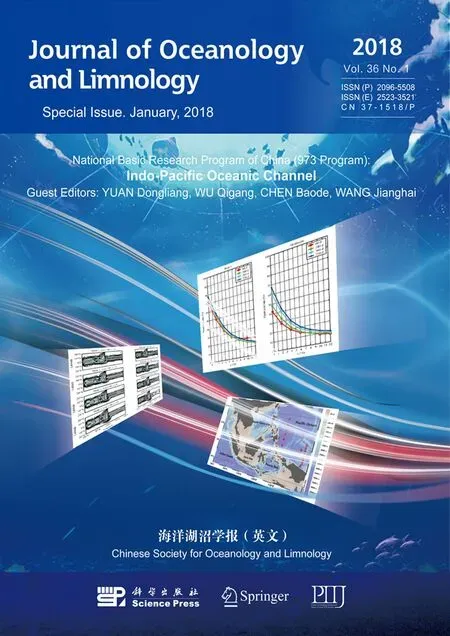 Journal of Oceanology and Limnology2018年1期
Journal of Oceanology and Limnology2018年1期
- Journal of Oceanology and Limnology的其它文章
- Ferroan dolomites in Miocene sediments of the Xisha Islands and their genetic model*
- Centennial-scale records of total organic carbon in sediment cores from the South Yellow Sea, China*
- Rates and fluxes of centennial-scale carbon storage in the fine-grained sediments from the central South Yellow Sea and Min-Zhe belt, East China Sea*
- Synchronous response of sedimentary organic carbon accumulation on the inner shelf of the East China Sea to the water impoundment of Three Gorges and Gezhouba Dams*
- Century-scale high-resolution black carbon records in sediment cores from the South Yellow Sea, China*
- Sedimentary architecture of the Holocene mud deposit offthe southern Shandong Peninsula in the Yellow Sea*
